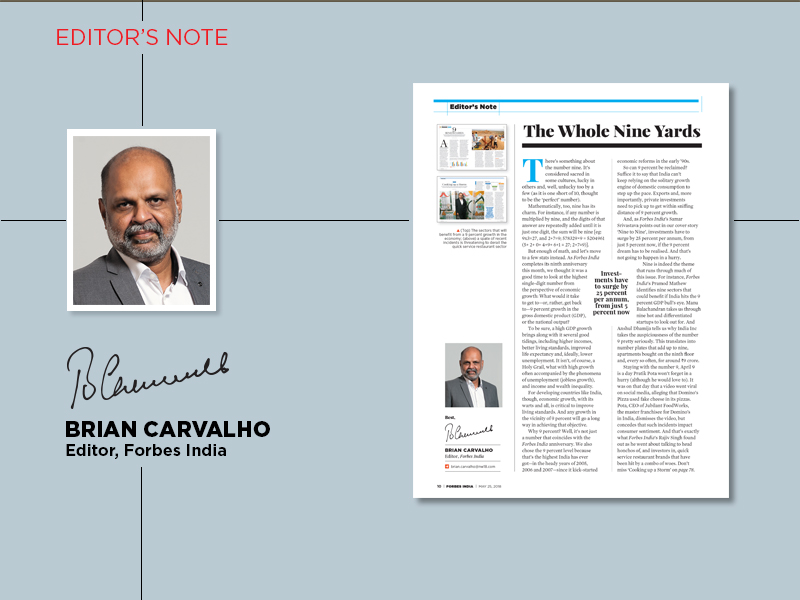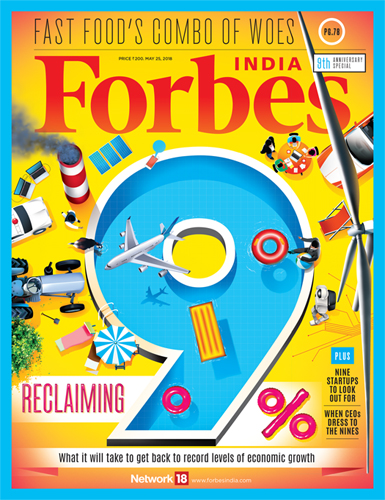
There's something about the number 9
As Forbes India completes its ninth anniversary this month, we thought it was a good time to look at the highest single-digit number from the perspective of economic growth

There’s something about the number nine. It’s considered sacred in some cultures, lucky in others and, well, unlucky too by a few (as it is one short of 10, thought to be the ‘perfect’ number).
Mathematically, too, nine has its charm. For instance, if any number is multiplied by nine, and the digits of that answer are repeatedly added until it is just one digit, the sum will be nine [eg: 9x3=27, and 2+7=9; 578329×9 = 5204961 (5+ 2+ 0+ 4+9+ 6+1 = 27; 2+7=9)].
 But enough of math, and let’s move to a few stats instead. As Forbes India completes its ninth anniversary this month, we thought it was a good time to look at the highest single-digit number from the perspective of economic growth: What would it take to get to—or, rather, get back to—9 percent growth in the gross domestic product (GDP), or the national output?
But enough of math, and let’s move to a few stats instead. As Forbes India completes its ninth anniversary this month, we thought it was a good time to look at the highest single-digit number from the perspective of economic growth: What would it take to get to—or, rather, get back to—9 percent growth in the gross domestic product (GDP), or the national output?For developing countries like India, though, economic growth, with its warts and all, is critical to improve living standards. And any growth in the vicinity of 9 percent will go a long way in achieving that objective.
Why 9 percent? Well, it’s not just a number that coincides with the Forbes India anniversary. We also chose the 9 percent level because that’s the highest India has ever got—in the heady years of 2005, 2006 and 2007—since it kick-started economic reforms in the early ’90s.
So can 9 percent be reclaimed? Suffice it to say that India can’t keep relying on the solitary growth engine of domestic consumption to step up the pace. Exports and, more importantly, private investments need to pick up to get within sniffing distance of 9 percent growth.
And, as Forbes India’s Samar Srivastava points out in our cover story ‘Nine to Nine’, investments have to surge by 25 percent per annum, from just 5 percent now, if the 9 percent dream has to be realised. And that’s not going to happen in a hurry.
Nine is indeed the theme that runs through much of this issue. For instance, Forbes India’s Pramod Mathew identifies nine sectors that could benefit if India hits the 9 percent GDP bull’s eye. Manu Balachandran takes us through nine hot and differentiated startups to look out for. And Anshul Dhamija tells us why India Inc takes the auspiciousness of the number 9 pretty seriously. This translates into number plates that add up to nine, apartments bought on the ninth floor and, every so often, for around ₹9 crore.
Staying with the number 9, April 9 is a day Pratik Pota won’t forget in a hurry (although he would love to). It was on that day that a video went viral on social media, alleging that Domino’s Pizza used fake cheese in its pizzas. Pota, CEO of Jubilant FoodWorks, the master franchisee for Domino’s in India, dismisses the video, but concedes that such incidents impact consumer sentiment. And that’s exactly what Forbes India’s Rajiv Singh found out as he went about talking to head honchos of, and investors in, quick service restaurant brands that have been hit by a combo of woes. Don’t miss ‘Cooking up a Storm ’.
(This story appears in the 25 May, 2018 issue of Forbes India. To visit our Archives, click here.)
Post Your Comment















